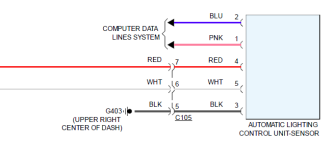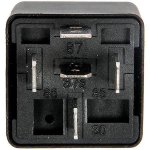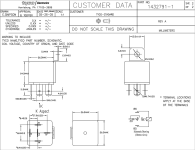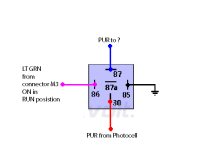marty said:
Forgot to say - Checked water level in battery. [Yes I know its not water in there. WEAR SAFETY GLASSES] Water was about 1/4 inch above what ever is inside the battery. Think water level is good.
Been driving. Me and Henry have a pretty good relationship. Who is Henry? Honda Fit named Henry Fit. Me and Henry listen to each other. Usually starter sounds happy. Car is not fixed

Problem is that due to my paranoia of car not starting I can hear starter spinning slow. Only happens when driving short trips and turning car off at every stop. 20° weather don't help.
EricTheCarGuy explain this better then I can.
[youtube]3QiKyjWWiRo[/youtube]
Don't want to watch video? Read the words 
greetings viewers car got here today
let's talk quickly about how to check a
battery every car's got one even the
electric ones you don't check the
electric ones like this it's a whole
different process this is just for the
normal 12-volt car battery six volt but
I don't know how many of you out there
with 6 volt batteries in your cars
unless you got something really wicked
old and in that case you probably want
to put an 8 volt in there because they
have them now and it's really good for
storing them for long periods of time
I'm off on a tangent if you suspect that
your battery is low and let's just say
just about any electrical problem on
your car the Alpha and Omega of the
electrical system in your car is the
battery if your battery isn't good and
isn't is not in good condition the rest
of the electrical system will either
have to compensate make up for or suffer
as a result of that battery not being
good particularly with like say your
luxury cars that have lots of electrical
doodads and gadgets and all kinds of fun
things heated and cooled seats all that
stuff is really hard on an electrical
system I'm of the opinion I've even seen
brand new cars come in that barely crank
over and I wonder if they are gonna
crank over in fact I've had customers
with new cars come in and say my car's
not cranking very fast can you check the
battery I agree with them it seems that
these days that batteries at least that
come with the vehicle originally are
engineered within a couple of electrons
of just enough and they're probably
doing this to save cost but as a result
if the battery gets weak in any way
shape or form it could manifest in all
kinds of electrical issues in the car so
I'm gonna just get to the whole thing
right now you will need a battery load
tester this is one that I just got kind
of cool didn't cost a whole lot but what
you want to do is connect it to the
battery let's do that now whenever
you're talking about
you really have to be mindful of a
couple of things it really is important
that the battery is clean if it's not
clean and there's a bunch of goopy stuff
up here clean it off with the solution
of baking soda and water and a brush
clean all off the whole top because
believe it or not the voltage can bleed
off of the battery as a result of the
dirt that's on top of it so you want to
make sure that not only the battery is
clean but most importantly the terminal
connections where the battery actually
meets the car is clean because if
there's any corrosion or resistance in
this area it's gonna hamper the
performance of the batteries so you want
to make sure that the terminals are nice
and clean and also here's the other
thing if your battery's dead you can't
start the car don't do this test just
don't do it because you need to have a
fully charged battery in order to figure
this out there may be something draining
the battery you know there could be a
whole host host of things but you cannot
check a battery's condition without it
being fully charged I have fully charge
of this battery took it out and drove it
I had some other things to look at on
this car but I know this batteries is
fully charged it's it's going to be so
I'm going to connect the clamps you have
positive for positive that would be the
right one and you have negative for
negative as you can see right now my
battery is actually over 12 volts now
this switch right here controls a load
tester and I'm gonna do something I
should have done before if you're
working around a battery a particularly
one that stinks smells like rotten eggs
it's got a hydrogen gas around the
outside of it and could potentially
explode so I'm gonna grab my safety
glasses this way if it explodes I'll be
able to play the lead from Phantom of
the Opera but I'll still be able to see
okay so now we see I'm a little over 12
volts you want to load the battery not
for an extended period of time but the
magic number here is gonna be 9 volts if
this battery goes below 9 volts when I
load test it then I
replace the battery because I know it's
fully charged I know it's not gonna get
better so if it falls below 9 volts
chuck it and you can see I'm just going
down to about 11 volts I could do an
entire episode just on batteries but
this is just on checking one really
quick so 9 bolts is your magic number
you've got some numbers on the top here
and cold cranking amps being probably
the most important one
this one has 540 cold cranking amps you
want to make sure that the battery
that's in the car is able to crank the
car over in the coldest of conditions
because that's when the battery has to
work the hardest
that's what net number there does and
this is cranking amps at 32 degrees
Fahrenheit that's 675 so this is
basically what this what the amperage of
this battery can put out during those
cold conditions and that's basically how
battery capacity is measured if you
truly want to do this test you actually
go through and do some calculations
based on the cold cranking amps for the
amount of time that you would actually
hold the load on the battery in order to
determine accurate condition but this is
a quick test to basically say if you're
below 9 volts get rid of it what 9 volts
are below let's say if you do the load
test and it's below 9 volts chuck it but
if it's above 9 volts like I had there
around 11 and you're having a battery
drain problem you gotta look elsewhere
which is what I've got to do here so
here's a battery that I know is bad I've
had it charging up for a while but you
can see it's even the best charge I can
get is not even 12 volts but when you
hit the load way down there so yeah and
I won't even come back up so that's what
a bad battery normally does like I said
I could do a whole video just on
batteries and how they work and all that
and I probably will at some point in the
future but this is just to quickly show
you what the check and what to look for
while you're checking it questions
comments always welcome that kind of
thing down below here you can always
visit me at Air Cargo com a link is also
posted below in here and you know as
usual I
to go out there into the world and
really think about what it is to stay
dirty
Lets try some periods. commas, Capitals and paragraphs.
I'm of the opinion I've even seen brand new cars come in that barely crank over, and I wonder if they are gonna crank over. In fact I've had customers with new cars come in and say my car's not cranking very fast can you check the battery. I agree with them it seems that these days that batteries at least that come with the vehicle originally are engineered within a couple of electrons of just enough, and they're probably doing this to save cost. But as a result if the battery gets weak in any way shape or form it could manifest in all kinds of electrical issues in the car.
Note where Eric says "engineered within a couple of electrons of just enough"
My guess as to what's going on with Henry Fit? Battery is really small. Smallest battery I have ever seen in a car. How big is it? Lets measure using the internet.
Group Size 151R
Length 7-3/4"
Width 5-1/8"
Height 7-1/4"
Stupid battery is just too small to hold enough juice to spin the starter motor. Having headlights come on because I am too stupid to turn headlight switch to the off position does not help. Headlights come on when opening the drivers door and exiting car. Headlights come on when I press the button on the key to open the doors. Henry thinks he is being helpful to help me see in the dark. Really really want to disable this 15 second headlight timer. 15 seconds is what I think the headlight delay timer is set for. Should measure it.
YouTube puts the text on the right of the screen. Below video see 3 dots. Click - Open transcript.








